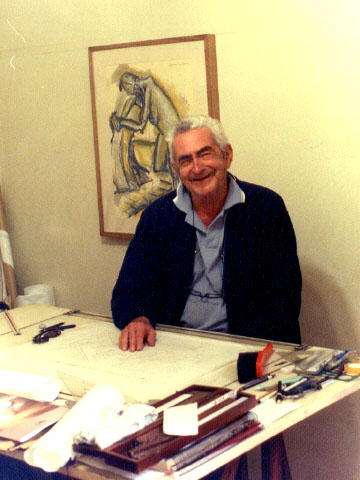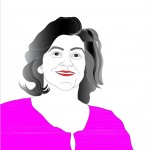Interview with Roberto Tibau
 Roberto Goulart Tibau, 2002. Photo: Ricardo Carranza
Roberto Goulart Tibau, 2002. Photo: Ricardo Carranza
Introduction:
Born in Niterói, Roberto José Goulart Tibau (1924-2003) joined the School of Fine Arts of Rio de Janeiro in 1945, when the school was becoming the National Architecture College the University of Brazil.
During the course, Tibau worked in the offices of Francisco de Paula Lemos Bolonha, Álvaro Vital Brasil, Affonso Eduardo Reidy and Oscar Niemeyer, where he was a colleague of Eduardo Corona. After his graduation in 1949, Tibau decided to move to São Paulo looking for new opportunities and jobs. In São Paulo, Tibau heard from Eduardo Corona that the School Agreement was increasing the techniques. Then, he was interviewed by the architect Hélio Duarte and joined the team in 1950 (CARRANZA, 2001).
When he worked at the School Agreement (1950-1955), Tibau designed eight schools and the Arthur Azevedo Popular Theater, preserved by the Municipal Council for the Preservation of Historical, Cultural and Environmental Heritage of the city of São Paulo (Compresp), in 1992. In 1952, Tibau started his academic career entering the Institute Of Contemporary Art of São Paulo (IAC).
During the years of School Agreement, Tibau and Corona started an useful partnership with the project of Planetarium (CARRANZA; CARRANZA, 2017). They also set up an office, which resulted in award winning projects like Pacaembu House (Eugênio Santos Neves), 1951, with Luis Fernando Corona, winning the first award of the state government, and the Pinheiros House (Rodolfo Mesquita Sampaio), also in 1951, awarded on the First. São Paulo’s Moderna Exhibition, both representing the modern architecture of Escola Carioca. Tibau also created the Project of the Municipal School of Astrophysics, one of the important examples of modern São Paulo’s architecture (CARRANZA, E., 2017).
In 1957, attending the invitation of his friend Hélio Duarte, he was hired by FAUUSP (Faculty of Architecture of the University of São Paulo) where he taught for thirty years. Tibau, who always conciliated the professional and academic activities, restarted his teaching career in 1997, in the São Judas Tadeu University invited by the former coordinator, Luiz Augusto Contier.
Tibau gave us this interview in his office in 2002, when we were writing the article “Document: Roberto José Goulart Tibau” (CARRANZA; CARRANZA,2002) which was the first work dedicated to the architect's work. In September 2002 when the article was published, we received a call from Tibau who was very touched and pleased with the publication. He would pass away months after that call.
Interview:
E.G.C; R.C. – Why did you choose the architecture major?
TIBAU – It was through a well-informed classmate of Audrerves College, I heard that buildings needed to be designed to be built, and that was the work of an architect. Then, I went to school (because I have always liked to draw since I was little and I have never lost that) as he told me and there I joined the program for the college entrance examination, including artistic drawing, molding and a subject for composition and manufacturing of building materials instead of the terrible chemistry. I fell in love at first sight, made a prep school and I passed the vestibular college entrance examination in 23rd place (in a class of 90 students) and each time I became more enchanted by the classes, works, and finally with architecture itself.
E.G.C; R.C. – How was the environment in college ?
TIBAU – The college environment was great. The coexistence with ENBA colleagues, painting, sculpture, etc. was very pleasant, the frequency on Café Amarelinho which was almost in front of Ministry Education, etc. We discussed the creation of the National Faculty of Architecture for a long time, which happened when I was still in my first year.
I always thought that common origin with the School of Fine Arts of Rio de Janeiro was very appropriate. It was the beginning of architecture already started with a faculty and a five-year course program much like the Faculty of Architecture of the University of São Paulo (FAU Maranhão) in its beginning. I guess that they took it as a model and improved, including some new subjects and cutting others out. Initially until I finished the course, the installations, faculty and management remained the same. Then, the school went to the Praia Vermelha neighborhood while they had not built the university campus. The students wrote a newspaper called “Anteprojeto!”, made in poor paper but with friendly pagination, pictures, drawings and articles which reflected a strong socialist ideology (Marx, Engels, etc.) and was enthusiastic with the memorable modern Brazilian architecture. The writing and the drawings were printed with red paint on a sand colored background. I would like to talk more about my colleagues and friends, about the professors (some of them architects, others coming from the polytechnic school) which I remember very well but I see there is no prolongation to this.
E.G.C; R.C. - How was your arrival in São Paulo?
TIBAU- I was a newly-grad . Just graduated, I met a friend who was invited to work in a construction company in the city of São Paulo but he gave me the opportunity to replace him with a cover letter, because he was ‘’digging’’ a position in a government agency in the city of Rio de Janeiro which had developed projects for the northeast of Brazil. I accepted quickly and my mother agreed since her family was São Paulo-based and I managed to stay with some cousins in the street Cardoso de Almeida. I had already worked in good architecture offices (Oscar, Aldany Toledo, Francisco Bolonha, Vital Brasil, among others) as a designer but I did not know what to do after graduation.
I never found that company but talking with Tio Fábio Goulart who was an engineer and friend of the architect Marcial Fleury de Oliveira who was looking for a young architect to help in the construction of Santa Cruz Housing Projects, on Santa Cruz Street (Vila Mariana neighborhood in the city of São Paulo). I accepted this and more than a year after I had an interesting reasonable construction experience.
E.G.C; R.C. - How was your hiring for the School Agreement Team? How was the work there and which projects of this period would you like to highlight?
TIBAU – I heard about the School Agreement from Eduardo Corona which had been my partner at the School of Fine Arts, and this same uncle friend of the engineer called Amadei, president of the agency that was actually selecting architects,
I was introduced to Hélio Duarte which interviewed me, saw some works that I carried along (something about the building Headquarters of Bandeirantes do Brasil, in partnership with other colleagues, and about the preliminary design which I would present in a contest for the construction of National Assembly and which I have made everything, project, drawings, perspective, etc.) Hélio seemed impressed and invited me to work as an intern. He was in charge of developing the project of the Rural School of Butantã neighborhood, for which he had already done some drawings and defined a start. Then, I was hired as constructor and became a friend and admirer of Hélio for the rest of his life.
Main works: the Planetarium, the Popular Theater, and many schools, among then the Educational Center for Deaf Children, and the de São Miguel Educational Complex , besides many school groups: Cidade Isidoro, Escola de Aplicação ao Ar Livre on Faustolo Street, and many others.
I highlight as well a planning proposal of a school network that I made from the educational ideas of Anísio Teixeira, for which Hélio had designed the Park Schools and Class Schools Plan . I admire this work until now, even though it was not executed and had only been part of an internal ideas contest. It is about current and urgent problems for education.
E.G.C; R.C. - How was your participation in teaching architecture? How was the Faculty of Architecture of the University if São Paulo was in the 1950’s? And in the later decades? How was your relationship with Artigas, Flávio Motta, Paulo Mendes da Rocha, etc.? And with students? And with politics?
TIBAU – I participated as an assistant teacher, at the time responsible for the course Plastics III, linked to some of his great compositions. And so it was.
The Faculty of Architecture of the University of São Paulo had vitality on the cultural, architectural and ideological plan. For me it was dazzling and I felt like part of a family since the beginning
Respecting my relation with Artigas, we made a good friendship full of admiration for this wonderful architect.
I had known Flávio Motta since the Museum of Art where I had taught a course of architectural drawing. I had always had good friendship and admiration for this fantastic person, a great intellectual and artist.
With Paulo Mendes da Rocha I had good friendly relations and also great admiration because this colleague had a huge spotlight on our modern architecture.
I got along very well with students even with some hard moments about politics, my biggest worry was to try to get students to continue designing because that’ was our main language.
E.G.C; R.C. - What’s your opinion about the modern architecture of São Paulo?
TIBAU – From the early fifties, young people’s interest in architecture increased intensely due to a bigger promotion of the modern architect's works and the renovation of architecture. This was socially and ideologically attractive. Besides that, the teaching staff already had architects able to improve teaching programs. The reform created sequences of projects (........., industrial draws, visual communication and planning) had a big importance on this renovation process. The establishment of the Department of Project , History and Technology as the development of university career resulted in master's and PhD graduate programs. Moreover, it is worth mentioning that the Faculty of Architecture of the University of São Paulo has a rich library.
All of these factors and more, the divisions of courses in core and elective, flexible course programs contributed to an intense natural environment and a great improvement in new architects' education resulting in a great advance in architecture, despite the political situation. This process reached other states as Paraná, Rio Grande do Sul, Minas, etc. and also other schools, including our neighbor Mackenzie College, with a very rich exchange.
Nowadays more than ever, the greatness of this architecture is a big promise to the future, the excellent quality of our young architects says so.
E.G.C; R.C. - You have received an honorable mention for your participation in the Brasilit Architecture Award. Tell us about the project.
TIBAU – This Brasilit award came in a rare time too. I participated with enthusiasm and made freehand drawings personally with my Oxford pens. I made a housing complex with single family houses, architects program that, in my opinion, had a great lack due to the bad orientation of public agencies that always disdained the collaboration of architects
The contest was in two steps. Firstly, they selected some projects that later would be developed to achieve a final result.
A member of the judging commission said our highlighted project ended with only an honorable mention because it was developed enough. With pleasure I will select a drawing that represents the work to publish on that opportunity.
E.G.C; R.C. - What do you think about architecture that came after modern architecture, like postmodernism, deconstructivism, minimalism?
TIBAU – Nothing can be stucked. Everything needs to evolve and this evolution is through ruptures and leaps and bounds that may represent sometimes setbacks and misinformation like in our case. This was certainly necessary and results in a refreshed architecture, and architecture needs to stay always new.
E.G.C; R.C. – What message would you give to the young people?
TIBAU – I would say: for me it is very pleasant to see how you work and this youth flavor in your projects and the way that you do and conceive it. Try not to lose these characteristics.
References
CARRANZA, Ricardo. Documento Eduardo Corona. AU. Arquitetura e Urbanismo, São Paulo, v. 95, n.95, p. 82-87, 2001.
CARRANZA, Ricardo; CARRANZA, Edite Galote. Documento Roberto José Goulart Tibau. AU. Arquitetura e Urbanismo, São Paulo, v. 103, p. 89-95, 2002.
CARRANZA, Edite Galote; CARRANZA, Ricardo. Trajetórias: Arquiteto Roberto José Goulart Tibau. 5% Arquitetura+Arte, disponível em: http://www.arquitetonica.com/historico_revista5/TArquitetoRobertoJoseGoulartTibau.htm
CARRANZA, Edite Galote; CARRANZA, Ricardo. Trajetórias: Eduardo Corona. 5% Arquitetura+Arte, disponível em: http://www.arquitetonica.com/historico_revista5/TArquitetoEduardoCorona.htm
CARRANZA, Edite Galote; CARRANZA, Ricardo. História em Detalhe: O renascimento da Escola Municipal de Astrofísica. Revista AU Arquitetura e Urbanismo, v. 267, p. 58-59, 2016.
CARRANZA, Edite Galote; CARRANZA, Ricardo. As cúpulas do Planetário. 5% Arquitetura +Arte, v. 71, p. 71-71, 2016, v. 14, p. 70-70, mai. 2016, disponível em: http://www.arquitetonica.com/revista5/contracultura/as-cupulas-do-planetario-3, acesso 3m 28/04/2017.
CARRANZA, Edite Galote; CARRANZA, Ricardo. O renascimento da Escola Municipal de Astrofísica. 5% Arquitetura+Arte v. 14, p. 71-71, jul. 2016, disponível em: http://www.arquitetonica.com/revista5/contracultura/o-renascimento-da-escola-municipal-de-astrofisica, acesso em 29/04/2017.
CARRANZA, Edite Galote. Planetário e Escola Municipal de Astrofísica de São Paulo. In: ANTICOLI, A.M.; CRITELLI, F.; CHIARELLI, S.R.; OSSANI, T. (Org.). Arquiteturas do Patrimônio Moderno Paulista: reconhecimento, gestão, intervenção. 1ed.São Paulo: Editora Altermarket, 2017, v. 1, p. 991-1007.
CARRANZA, Edite Galote. Planetário e Escola Municipal de Astrofísica Aristóteles Orsini: Memorial. In: Ruth Verde Zein. (Org.). Caleidoscópio concreto. 1ed.São Paulo: Romano Guerra, 2017, v.1, p. 201-222.
About the author:

Edite Galote Carranza
Professor at the Architecture and Urbanism course in the Graduation program in Architecture and Urbanism at the São Judas Tadeu University, São Paulo. P.h.D. from the University of São Paulo’s School of Architecture and Urbanism (2013). M.A. from the Mackenzie Presbyterian Institute (2004). B.A. in Architecture and Urbanism from by the Mackenzie Presbyterian University School of Architecture (1991). She works in the fields of São Paulo’s architecture history, and architectonic project and drawing, with two textbooks published: “Representation Scales in Architecture" and “Constructive Details of Architecture”. Member of the magazine Arq. Urb.’s editorial board. Member of the Research Group CNPQ? Architecture: Alternative and Transdisciplinary Approaches in the Contemporary Condition. Member Executive Director of the architecture office and publishing G&C Arquitectônica Ltda since 1998, where she develops projects in architecture, corporate architecture and editorial projects; editor of the Electronic journal magazine 5% arquitetura + arte ISSN 1808-1142, since 2005; editor of the Facebook page 5% arquitetura+ arte, since 2015.

Ricardo Carranza
PUBLICATIONS in Anthologies of National Contests – SCORTECCI, SESC DF, literature magazine CULT, and Poetry and Literature websites Zunái, Stéphanos, Germina, Cult – Literary Workshop, Mallarmargens. Published Poetry BOOKS: Sextet, Author’s Edition, São Paulo, 2010; The Empirical Flower, Author’s edition, São Paulo, 2011; Dramas, Publishing G&C Arquitectônica Ltda., São Paulo, 2012. Unpublished Tales BOOKS: The comedy of errors, 2011/2018 – pre-selected in the Literature Sesc Prize 2018; Anachronisms, 2015/2018. Insomnia Notebooks (58): since 2009. ARTICLES published in 5% Arquitetura+Arte magazine since 2005.
How to cite:
CARRANZA, Ricardo; CARRANZA, Edite Galote. Entrevista Roberto Tibau. 5% Arquitetura + Arte, São Paulo, ano 14, v.01, n.17, e107, p.1-8, jan./ jun. 2019. Disponível em: http://revista5.arquitetonica.com/index.php/uncategorised/entrevista-roberto-tibau-2
English translation by:
Beatriz Soares dos Reis
M.A. Nívia Maria Rodrigues Fernandes Marcello
Acessos: 1280
